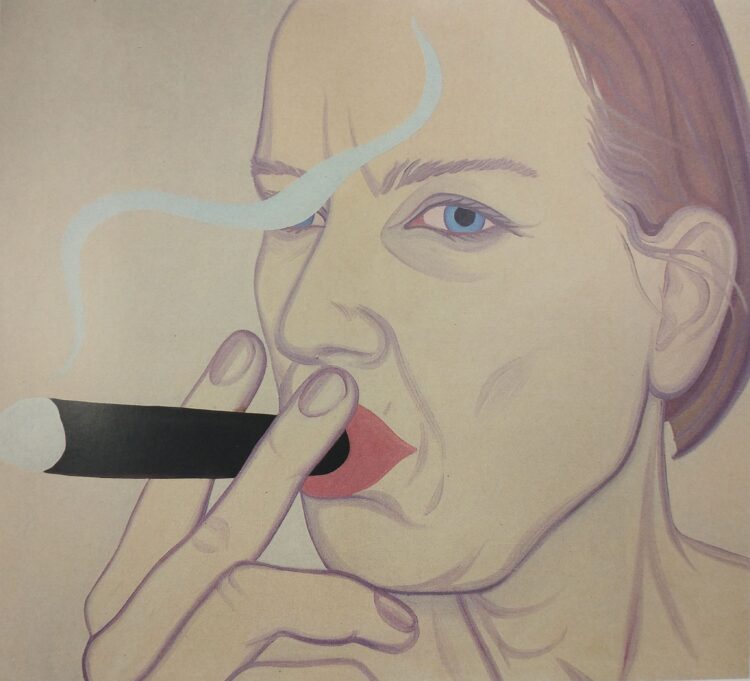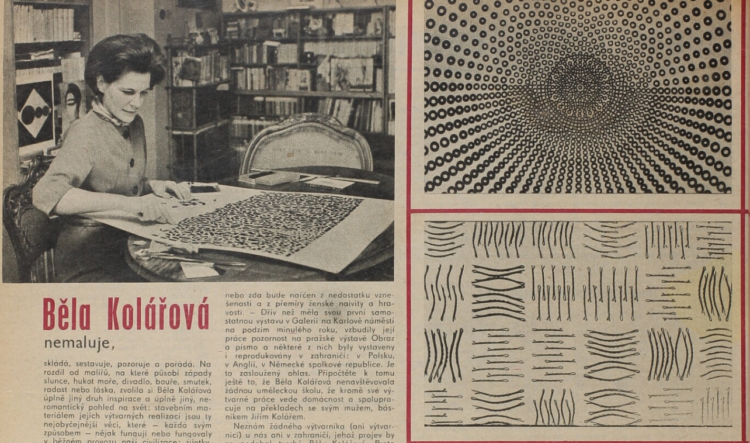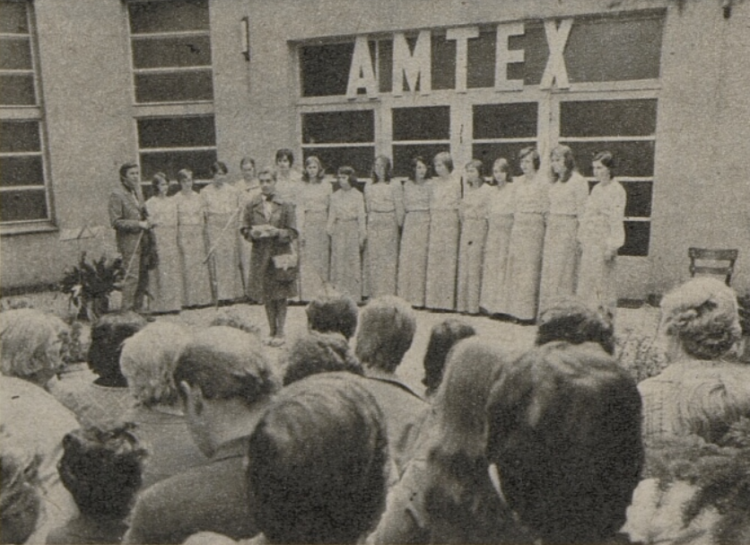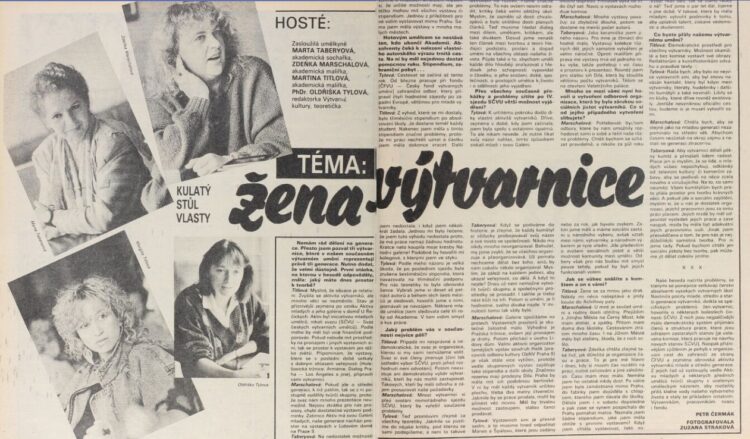Feminism under Socialism? The 1960s Generation of Women Artists and the “Womenʼs Question”
Author: Marianna Placáková[1]
The interpretation of state-socialist womenʼs emancipation as we know it today began to gradually take shape in the post-1989 transition period, which saw political democratization, the transition to a market economy, and the transformation of state and public institutions. Although some women scholars and activists living in the West were interested in the emancipation of women living under a communist regime before 1989 (in the case of Czechoslovakia, this often included post-1968 emigrants such as Alena Heitlinger, Hilda Scott, and Alena Wagnerová), the main interest in the region and its socialist experience came with the fall of the Eastern bloc. At that time, many local non-profit activities began to be sponsored by Western feminist organizations, and together with the arrival of Western feminists in the Czech Republic, a debate on feminist issues opened up in academic discourse and in Czech society in general.[2]

Tomáš Císařovský, Američanka v Praze (An American Woman in Prague), 1995
Thinking about feminism in the 1990s, as it appeared in the media, was characterized by obscure conceptualization, in which the term feminism functioned primarily as a label for a new and vague phenomenon from the West, about which there was usually no debate regarding the direction in which feminism (i.e., the struggle for gender equality) should develop in the Czech Republic, but about whether the feminist position should be accepted at all. The term “feminism”, which had a provocative effect in the local environment, was therefore treated with caution – instead, the term “gender” was often chosen to describe local feminist activities, referring more generally to the study of gender relations (this was the naming strategy of the Gender Studies NGO in Prague[3]), or local terminology such as “womenʼs emancipation,” “womenʼs exhibitions,” and “womenʼs art” prevailed (the word feminism did not appear once in the 1993 feminist issue of the Výtvarné umění, the first issue of the Czech magazine devoted to feminism and the visual arts).[4] However, this phenomenon cannot be interpreted solely as a result of Czech womenʼs gender blindness and their negative attitude toward taking political positions, but also as a reaction to the image of Western feminism, which the majority of Czech society viewed through the prism of the pre-1989 period – as a “decadent ideology” and a “meaningless struggle between the two sexes” through which it was impossible to achieve structural changes in society.
This was not a Czech idiosyncrasy, but the common position of women and female artists in all post-communist countries influenced by the politics of the Cold War. The negative image of Western (especially American) feminists had long been constructed in a contradiction between “aggressive women attacking men” and “weak white middle-class women” solving individualistic problems of material well-being. Women artists refused to identify with this image because they understood themselves differently, espousing values of care, motherhood, ecology, and resistance to commercialization, as well as “feminine” qualities such as intuition, emotionality, and gentleness, which they understood to be antithetical to feminism (the adjectives “militant” and “radical” associated with feminism usually referred to a rejected and alleged “aggressiveness” in Western womenʼs behavior).[5] At the same time, however, the condemnation of Western feminisms often stemmed from a lack of awareness and resistance to “ideologization” or left-wing politics among Czech women artists. In 1990, at a New York conference on modern Czech literature, the writer Eva Kantůrková met with American literature professors who discussed her book Přítelkyně z domu smutku (My Companions in the Bleak House),[6] which was published in English in 1987 and became popular in American academia for its exceptional description of womenʼs imprisonment in the Eastern Bloc, in a feminist context. The misunderstanding that arose between them may have been the result not only of socio-cultural differences but also of the fact that Kantůrková had begun to define herself as an anti-feminist soon after 1989.[7]
The debates focused mainly on “femininity” and “womenʼs roles” and the difference between “female” and “male” experience. They were characterized by a high degree of psychologization and generalization of the life experiences and feelings of individual women, which were formulated on the biological level of gender differentiation (“woman” versus “man”) and in the debates, more or less anything could be expressed. New sexist terms were coined, such as sexual lustration or “harašení” (a Czech word play with the English term “harassment”), and discussions were often framed in problematic ways – the cover of the feminist issue of Czech literary magazine Iniciály, for example, featured a drawing of a hanged woman by the Czech author Robert Huja.[8] Participants in the debates were also often Czech men and women from the West, who acted as authorities from “outside” the debate frame. At a debate organized by the curator Radek Váňa in June 1994 at the National Gallery in Prague, the British artist and curator Andrée Cooke argued that the art of Czech women was weak and that, apart from Adriena Šimotová, there was a lack of female role models.[9]
How women artists and women in general expressed their own position in society in the 1990s in post-communist countries has been interpreted from different perspectives. One approach argues that women in post-communist societies did not have a feminist consciousness and were therefore unable to recognize whether the injustices they experienced were related to their gender position and interpreted them only on a biological level as part of the so-called female destiny. Another perspective is that women were aware of their unequal gender position on a structural level, but used the rhetoric of gender equality as a coping strategy to assert themselves in a gendered system – a position that is generally one of the classic problems of womenʼs identification with the feminist position, regardless of the political system and society in which they live. The latter interpretation points to the positive outcomes of state socialist policies, which in many ways helped women in socialist societies actually experience a more equal gender position, and thus their attitudes could be based on previous experiences of more balanced gender relations, for example in comparison with mainstream partnership models in Western societies.
This third interpretation was described by the sociologist Gerlinda Šmausová as the concept of womenʼs “lived emancipation” (linked to their power and prestige in society) and was illustrated by her own experience as the absence of the self-evident.[10] She and her friend, the journalist Alena Wagnerová, realized the extent of their own socialist womenʼs emancipation only after they had lost it, when, after emigrating to the Federal Republic of Germany after 1968, they needed the consent of their partners to deal with the authorities (in West Germany at that time, if women wanted to open a bank account or quit their jobs, they needed the consent of their husbands). In addition to the phenomenon of “unconscious emancipation,” however, there was also an emancipatory and feminist consciousness of women in socialist society, which manifested itself most strongly in Czech society and also in the art scene in the 1960s as part of the democratization process. This included the re-establishment of the Czechoslovak Womenʼs Union in 1967, which demanded more political power in deciding the direction and form of womenʼs emancipation, and also many ongoing debates on gender issues in the contemporary press, which accelerated the political process.[11]

Ludmila Vachtová, Běla Kolářová, magazine Vlasta, 1967
The 1960s
“Anyone writing a history of sculpture in Bohemia after 1945 will not be able to ignore a phenomenon that has been forgotten among the more noisy events: three female sculptors – Zdena Fibichová, Věra Janoušková, Eva Kmentová – stand out from the situation at the end of the 1950s. They emerged from the common hatchery of Wagnerʼs studio at the Vysoká škola uměleckoprůmyslová in Prague and ascended into sculptural marriages that made it possible for them to work in a micro-team where the participants are in complete agreement about the meaning and future of modern art. This privileged their position over those who had to contend with a formally debating environment and themselves quite alone. It made their position more difficult in that all three of them had to come to terms with the artistic individuality of their life partners,“ the Czech curator Ludmila Vachtová wrote in the magazine Výtvarné umění in 1966.[12] Fibichová, Janoušková, Kmentová, and Vachtová belong to the postwar generation of women artists and curators, as the Czech art historian Jiří Šetlík defined it.[13] They were born roughly between 1920 and 1935, often graduating after the war due to the closure of Czech universities and academies by the Nazis, and made their artistic and professional mark in the 1960s (this strong generation of women artists also includes Adriena Šimotová, Jitka and Květa Válovás, Naděžda Plíšková, Eva Švankmajerová, Vlasta Prachatická, and many others).
This 1960s generation of women artists is often remembered as one of women who were able to succeed in their careers thanks to their husbands, who were also active in the art world and helped them to make it big. However, if we look at their position in the context of the times, there is no doubt that the systemic setting in which women in general became more emancipated after 1948, thanks to their own greater economic independence and, at the same time, the economic expropriation of private property that affected men in particular, played an important role in their position. A positive role was also played by the education they received after the war at the Academy of Fine Arts and the Academy of Arts and Crafts (for comparison, we should not forget that in the 1950s and 1960s, for example, American women artists experienced gender-based exclusion from art education at some U.S. colleges, as described in the Faith Ringgoldʼs memoirs).[14] In the New York scene of the time it was also common for women artists to serve primarily as escorts to their male partners at parties, and they were often addressed by their husbandsʼ full names as Miriam Shapiro remembered her experience from the Club that she visited with her husband and artist Paul Brach (at that time still as Miriam Brach).[15] In Czechoslovakia, on the other hand, women artists often kept their maiden names (Naděžda Plíšková, Věra Janoušková, Vlasta Prachatická), and in the case of Eva Kmentová, her husband, Olbram Zoubek, even used his wifeʼs surname for a short time).[16] At the same time, women in 1960s Czechoslovakia experienced greater power and prestige in society, and their status was not so dependent on their male partners, as Gerlinda Šmausová recalled from her later experience in West Germany.
These circumstances undoubtedly led to the emergence of a strong generation of female artists in the 1960s, as well as a new generation of art critics and curators. In addition to Ludmila Vachtová, these included Eva Petrová, Vlasta Čiháková Noshiro, and Milena Lamarová, whose articles often contributed to the contemporary debate on womenʼs issues. The main premises of the debate were based on a critique of the gender policy of the socialist state, in which women’s emancipation was largely discussed at the expert political level as an economic-social problem of the state, and its other levels, based on the experiences of women themselves, were overlooked. Thus, according to Milena Lamarová, women in Czechoslovakia lived in a system of collectivized agencies to which each of them had individual feelings, but which had not been taken into account until then. The new economic and social role that women began to play on a larger scale after 1948 also affected their family and emotional relationships, but the framework of these relationships was slow to adapt to this social change. The critique involved the articulation of womenʼs political interests based on womenʼs experience and the recognition of the subjective interests of individual women, which had previously been understood as bourgeois.[17] It is sometimes difficult to interpret how women artists of the time related to gender issues and whether they reflected them in their work or, on the contrary, did not take gender into account and based their work on the prevailing concepts of socialist humanism and universalism, given the often limited amount of material. However, as I was looking through the current exhibition of Eva Kmentová at the Dům umění, I wondered whether, for example, in addition to her works on paper with vaginal motifs, the theme of the “I,” which is directly expressed in one of her drawings and which can also be found in Nadězda Plíškováʼs graphic works from the late 1960s, could also be related to the awareness of women’s position and their own individual identity in socialist society.
The interpretation of feminist issues is always linked to an analysis of power, which in the case of the Czech art scene during state socialism often revolves around the question of the political and professional position of artists within the system. According to the above-mentioned quotation from Výtvarné umění and statements made after 1989, Ludmila Vachtová argued that women artists after 1948 had achieved a strong position in the art scene through various strategies and independently of official policy, thus defining themselves against the structural improvement of the status of women in society imposed by the state.[18] It should be noted, however, that Vachtová herself contributed to the thematization of gender issues and the promotion of individual women artists in the 1960s. In 1965 she organized the first solo exhibition of Běla Kolářová at the Gallery on Charles Square in Prague, of which she was the curator, and in the catalog she wrote about her difficult position in relation to the prominent position of her husband Jiří Kolář on the art scene. At the same time, in 1967, Vachtová wrote a text about Kolářová for Vlasta, a magazine published by the Czechoslovak Women’s Union and promoting women’s agenda within the ruling structures, which, along with other women’s union magazines (the Czech Mona and the Slovak Slovenka), published articles and interviews with artists popular at the time, such as Ester Krumbachová, Eva Kantůrková, and Naděžda Plíšková.

The first show of non-professional textile artists AMTEX, organized by the Czech Womenʼs Union, Klatovy (West Bohemia), 1976
With the beginning of normalization, coupled with the change of personnel in the media and official institutions, and also the end of the feminist debate in the wider society, the Czech Women’s Union and the magazine Vlasta turned their attention to promoting women artists who were active within the official art scene, and also to regional art by non-professional women artists usually making applied arts. They organized various types of shows and competitions designed to appeal to the widest possible range of women artists. The revival of the debate on womenʼs issues and the possibility of criticizing the system gradually emerged towards the end of the 1980s. The practice of the Czech Womenʼs Union in the 1970s and 1980s, focused on the collaboration with women “outside the art world,” was probably one of the reasons why this phenomenon was not discussed in the art scene in the 1990s onwards, from any ideological or socio-political position or from the perspective of historiography, and why the experience of the 1960s was simultaneously forgotten.

The debate between Margita Titlová Ylovsky, Marta Taberyová, Oldřiška Tylová, and Zdeňka Marschalová about necessary reforms in the art scene, magazine Vlasta, October 1989
[1] This text is a revised version of my paper presented at the conference Stopy Evy Kmentové at the Dům umění in Brno on November 4, 2023.
[2] In addition to the Network of East-West Women, cooperation with the German Frauen Anstiftung and Heinrich Böll Stiftung was important for Czech feminist NGOs in the 1990s.
[3] Jana Hradilková, „Rebuilding the House of Gender Studies“, in: Susanna TRNKA – Laura BUSHEIKIN (eds.), Bodies of Bread and Butter. Reconfiguring Women’s Lives in the Postcommunist Czech Republic, Prague: Gender Studies Centre 1993, pp. 19–22.
[4] „Žádné ženské umění neexistuje“, Výtvarné umění, Vol. 4, 1993, No. 1.
[5] Marianna Placáková, „Women’s Agency and Legacy of (Post)Socialism: Understanding Czech Women Artists’ Attitudes Towards Feminism“, April 2021, Secondary Archive – online platform for Central and Eastern European women artists, https://secondaryarchive.org/womens-agency-and-legacy-of-postsocialism-understanding-czech-women-artists-attitudes-towards-feminism/ (accessed on November 21, 2023).
[6] Eva Kantůrková, My Companions in the Bleak House, New York: Overlook Books 1987.
[7] Josef MLEJNEK jr., „Největší problém – dobří překladatelé“, Studentské listy, Vol. 2, 1991, No. 17, p. 3.
[8] „Feminismus… ano?“, Iniciály, Vol. 2, 1992, No. 25.
[9] Radek Váňa, „‚Já to tak fakt necejtim‘ aneb Všechno vede k plození“, Ateliér, Vol. 7, 1994, No. 25, p. 2.
[10] Gerlinda Šmausová, „Emancipace, socialismus a feminismus (2001)“, in: Libora Oates-Indruchová (ed.), Tvrdošíjnost myšlenky. Od feministické kriminologie k teorii genderu, Prague: SLON 2011, pp. 195–206.
[11] Marianna Placáková, “Emancipation Despite Circumstances: The Prague Spring, (Dis)engagement on the Art Scene and the Emergence of Feminist Consciousness among Women Artists”, Umění, Vol. 70, 2022, No. 4, pp. 383–405.
[12] Ludmila Vachtová, Běla Kolářová (exh. cat.), Galerie na Karlově náměstí 1965, np.
[13] Jiří Šetlík, “Umělecká a občanská odpovědnost poválečné generace,“ Výtvarné umění, Vol. 6, 1995, No. 3–4, p. 8.
[14] Faith Ringgold, We Flew Over the Bridge, Boston-New York-Toronto-London: Bulfinch Press Book 1995, p. 34.
[15] Miriam Shapiro, “The Fifites were a wonderful time for artists if you were a male” (1990), Rutgers University Libraries. Special Collections and University Archives, Miriam Schapiro Papers, MC 1411, box 33.
[16] I would like to thank Polana Bregantová from the Kmentová Zoubek Fund for bringing this to my attention.
[17] Placáková, „Emancipation Despite Circumstances.“
[18] Marianna Placáková, „Československá zkušenost jako východisko. Feministické umění v období státního socialismu“, Sešit pro teorii, umění a příbuzné zóny, Vol. 13, 2019, No. 27, s. 26–63.




